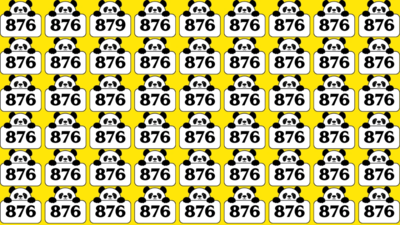ARTICLE AD BOX

At first glance, this image looks like an army of cute pandas holding up the number 876. They’re arranged neatly in rows and columns on a bright yellow background. It feels very uniform, right? But somewhere in this sea of “876,” a sneaky little 879 is hiding.
Why is it hard to spot?
This image is a classic example of a visual pattern trick. Our brains are wired to recognize patterns and gloss over repeated data — it’s a survival and efficiency thing. When we see rows upon rows of identical numbers like “876,” our brain gets lazy and starts assuming everything is the same. That’s when the illusion works its magic.Once we get comfortable with the repetition, our mind doesn’t feel the need to double-check every single item — which is exactly why that single 879 can sneak past unnoticed.
It blends in thanks to the identical font, layout, and panda graphics.
The trick behind the illusion
There are a few sneaky tricks going on here:
1. Visual uniformity
Every panda is holding the same sign, same size, same design. This repetition makes it incredibly hard for any outlier to stand out — even if it's different by just one digit.
2. Peripheral vision gets fooled
Most people scan images like this using peripheral vision and quick saccadic (jumping) eye movements. Peripheral vision is terrible at detecting small changes in symbols or numbers — it focuses more on shapes and movement.
3. Bright background distraction
The vibrant yellow background is great at grabbing attention — but it's also a visual noise-maker. Your brain is so busy registering the bright color and the consistent shapes that it’s even less likely to notice a slight number change.
4. Mental autopilot
Once you've read “876” a couple of times, your brain kind of goes, “Cool, I got it.” Then it stops reading and starts assuming. And that’s when 879 wins the hide-and-seek.
So how do you beat illusions like this?
Tricks like these test your focus. To spot the odd number out:Slow down and read every number consciously.Try changing your perspective — zoom in or step back.Scan row by row rather than looking at the whole image at once.Interestingly, people who work with numbers or data entry for a living tend to find these quicker. Their brains are trained not to skip over digits.
Why do we love this kind of illusion?
Because it’s frustratingly fun! It tickles that part of your brain that craves solving puzzles. It also gives a teeny dopamine rush when you finally do spot the difference.There’s also a subtle sense of victory — like you beat your own brain at its lazy game.Optical illusions like this are more than just eye candy — they’re little psychology experiments in disguise. They reveal how our brains shortcut through information and how easily we’re tricked by simple visuals. And the best part? You don’t need fancy tech to experience them — just a panda, some numbers, and a bright background will do.So, the next time you come across an image like this, don’t trust your first glance. Your brain might be pulling a fast one on you.And if you found that 879 without any help, hats off to your hawk eyes!Your mission is to find 879 — and if you haven't yet, here's a spoiler: it's in the top row, second from the left.




.png)
.png)
.png)
















 3 hours ago
5
3 hours ago
5









 English (US) ·
English (US) ·